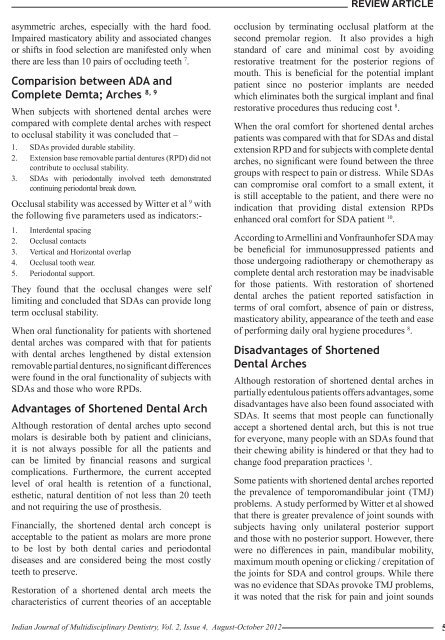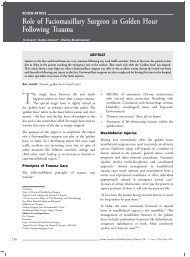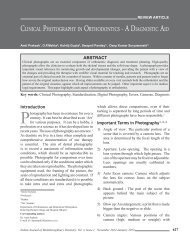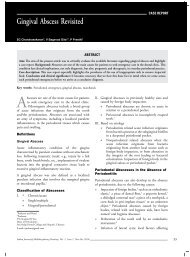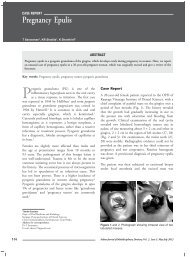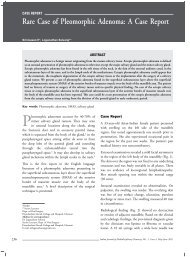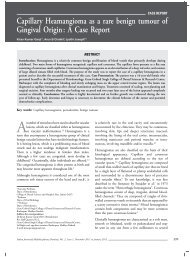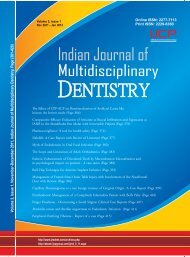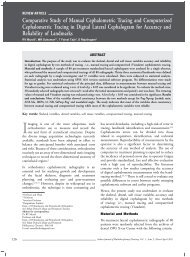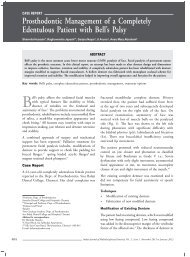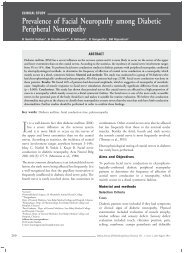Volume 2 - Issue 4 (Aug-Oct) Download Pdf - IJMD
Volume 2 - Issue 4 (Aug-Oct) Download Pdf - IJMD
Volume 2 - Issue 4 (Aug-Oct) Download Pdf - IJMD
- No tags were found...
Create successful ePaper yourself
Turn your PDF publications into a flip-book with our unique Google optimized e-Paper software.
Review Articleasymmetric arches, especially with the hard food.Impaired masticatory ability and associated changesor shifts in food selection are manifested only whenthere are less than 10 pairs of occluding teeth 7 .Comparision between ADA andComplete Demta; Arches 8, 9When subjects with shortened dental arches werecompared with complete dental arches with respectto occlusal stability it was concluded that –1. SDAs provided durable stability.2. Extension base removable partial dentures (RPD) did notcontribute to occlusal stability.3. SDAs with periodontally involved teeth demonstratedcontinuing periodontal break down.Occlusal stability was accessed by Witter et al 9 withthe following five parameters used as indicators:-1. Interdental spacing2. Occlusal contacts3. Vertical and Horizontal overlap4. Occlusal tooth wear.5. Periodontal support.They found that the occlusal changes were selflimiting and concluded that SDAs can provide longterm occlusal stability.When oral functionality for patients with shorteneddental arches was compared with that for patientswith dental arches lengthened by distal extensionremovable partial dentures, no significant differenceswere found in the oral functionality of subjects withSDAs and those who wore RPDs.Advantages of Shortened Dental ArchAlthough restoration of dental arches upto secondmolars is desirable both by patient and clinicians,it is not always possible for all the patients andcan be limited by financial reasons and surgicalcomplications. Furthermore, the current acceptedlevel of oral health is retention of a functional,esthetic, natural dentition of not less than 20 teethand not requiring the use of prosthesis.Financially, the shortened dental arch concept isacceptable to the patient as molars are more proneto be lost by both dental caries and periodontaldiseases and are considered being the most costlyteeth to preserve.Restoration of a shortened dental arch meets thecharacteristics of current theories of an acceptableocclusion by terminating occlusal platform at thesecond premolar region. It also provides a highstandard of care and minimal cost by avoidingrestorative treatment for the posterior regions ofmouth. This is beneficial for the potential implantpatient since no posterior implants are neededwhich eliminates both the surgical implant and finalrestorative procedures thus reducing cost 8 .When the oral comfort for shortened dental archespatients was compared with that for SDAs and distalextension RPD and for subjects with complete dentalarches, no significant were found between the threegroups with respect to pain or distress. While SDAscan compromise oral comfort to a small extent, itis still acceptable to the patient, and there were noindication that providing distal extension RPDsenhanced oral comfort for SDA patient 10 .According to Armellini and Vonfraunhofer SDA maybe beneficial for immunosuppressed patients andthose undergoing radiotherapy or chemotherapy ascomplete dental arch restoration may be inadvisablefor those patients. With restoration of shorteneddental arches the patient reported satisfaction interms of oral comfort, absence of pain or distress,masticatory ability, appearance of the teeth and easeof performing daily oral hygiene procedures 8 .Disadvantages of ShortenedDental ArchesAlthough restoration of shortened dental arches inpartially edentulous patients offers advantages, somedisadvantages have also been found associated withSDAs. It seems that most people can functionallyaccept a shortened dental arch, but this is not truefor everyone, many people with an SDAs found thattheir chewing ability is hindered or that they had tochange food preparation practices 1 .Some patients with shortened dental arches reportedthe prevalence of temporomandibular joint (TMJ)problems. A study performed by Witter et al showedthat there is greater prevalence of joint sounds withsubjects having only unilateral posterior supportand those with no posterior support. However, therewere no differences in pain, mandibular mobility,maximum mouth opening or clicking / crepitation ofthe joints for SDA and control groups. While therewas no evidence that SDAs provoke TMJ problems,it was noted that the risk for pain and joint soundsIndian Journal of Multidisciplinary Dentistry, Vol. 2, <strong>Issue</strong> 4, <strong>Aug</strong>ust-<strong>Oct</strong>ober 2012 561


